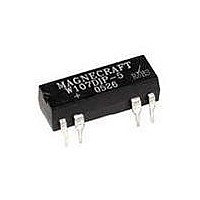W171DIP-28 Magnecraft / Schneider Electric, W171DIP-28 Datasheet - Page 5

W171DIP-28
Manufacturer Part Number
W171DIP-28
Description
Reed Relay DPST-NO W/DIODE 24V
Manufacturer
Magnecraft / Schneider Electric
Type
DIP Reed Relaysr
Specifications of W171DIP-28
Contact Form
DPST - NO
Coil Voltage
24 V
Maximum Switched Current
0.5 A
Coil Suppression Diode
Yes
Coil Resistance
2200 Ohms
Termination Style
Solder
Current, Rating
0.5 A
Dielectric Strength
500 V (RMS) (Coil to Contacts), 150 V (RMS) (Across Open Contacts)
Function
Power
Material, Contact
Rhodium
Mounting Type
PCB
Number Of Pins
8
Relay Type
Reed
Resistance, Coil
2200 Ohms (Nom.)
Standards
RoHS
Temperature, Operating
-40 to +85 °C
Termination
Solder
Voltage, Control
24 VDC
Voltage, Rating
100 VDC
Weight
1 g
Coil Voltage Vdc Nom
24V
Switching Current Max
500mA
Switching Voltage Max
100VDC
Contact Configuration
DPST-NO
Relay Mounting
PCB
External Height
7.62mm
Rohs Compliant
Yes
Lead Free Status / RoHS Status
Lead free / RoHS Compliant
Other names
171DIP-28
Figure 1. Construction of Switch Capsule
of Typical Dry Reed switch (SPST-NO)
HOW REED RELAYS WORK
The term reed relay covers dry reed relays and mercury-
wetted contact relays, all of which use hermetically sealed
reed switches. In both types, the reeds (thin, flat blades)
serve multiple functions - as conductor, contacts, springs,
and magnetic armatures.
DRY REED RELAYS
Dry reed relays have become an important factor in the
relay field. They have the advantage of being hermetically
sealed and resistant to atmospheric contamination. They
have fast operate and release times and when operated
within their rated contact loads, have very long life. A
typical dry reed switch capsule is shown in Figure 1.
In the basic SPST-NO design, two opposing blades are
sealed into a narrow glass capsule and overlapped at their
free ends. The contact area is plated typically with rhodium
to produce a low contact resistance when contacts are
drawn together. The capsule is made of glass and filled
with a dry inert gas and then sealed. The capsule is
surrounded by an electromagnetic coil. When the coil is
energized, the normally open contacts are brought together;
when the coil voltage is removed, the blades separate by
their own spring tension. Some reeds contain permanent
magnets for magnetic biasing to achieve normally closed
contacts (SPST-NC) or SPDT contact combinations. The
current rating, which is dependent upon the size of the
blade and the type and amount of plating, may range from
low level to 1 amp. Effective contact protection is essential
when switching loads other then dry resistive loads.
MERCURY-WETTED CONTACT RELAYS.
Mercury wetted contacts consist of a glass-encapsulated
reed with its base immersed in a pool of mercury and the
other end capable of moving between one or two stationary
contacts. The mercury flows up the reed by capillary action
and wets the contact surfaces of the moving end of the
reed as well as the contact surfaces of the stationary
contacts. A mercury to mercury contact is maintained in
the closed position. The capsule is surrounded by an
electromagnetic coil and operates in the same manner
as a dry reed.
REED RELAYS
SUPPORTING
TERMINAL
NORMALLY OPEN
CONTACTS
CAPSULE
GLASS
SUPPORTING
TERMINAL
APPLICA
APPLICA
CONTACT COMBINATIONS.
SPST-NO, SPST-NC, SPDT contact combinations.
capsule design (Fig.1).
SPST-NO switch and a permanent magnet strong enough
to pull the contacts closed but able to open when coil
voltage is applied to the relay coil.
mechanically tensioned against the normally closed contact,
and is moved to the normally open contact upon application
of a magnetic field. The SPDT contact combination can also
be achieved by joining a SPST-NO switch with an appropriately
adjusted SPST-NC switch, and jumping one side of both
switches together to form the movable contact system.
in the position to which they were driven, and stay in that
position when coil power is removed from the relay coil.
SPST-NO contact, and biasing it with a permanent magnetic
that is strong enough to hold the contacts closed, but not
strong enough to hold the contact closed when coil power is
applied to the coil. The switching process is than reversed
by simply reversing the relay coil polarity to close the switch,
or by employing a second coil with a reverse field.
Figure 2. Miniature Mercury wetted
contacts switch (SPST)
OPERATING
SUPPORTING
LEADWIRE
MOVABLE
CONTACTS
BLADE
GLASS
CAPSULE
MERCURY
POOL
POSITION
The switches used in dry reed relays provide
The SPST-NO corresponds with the basic switch
The SPST-NC results from a combination of the
In typical true SPDT designs, the armature is
Latching contacts, defined as contacts which remain
Latching switches are manufactured by using a
TION DA
TION DA
Mercury wetted contacts are
fast in operation and have
relatively good load carrying
capacity and long life. The
mercury films are
reestablished at each contact
closure and contact erosion is
eliminated. The mercury films
are stretchable, there is no
contact bounce and because
it is a mercury contact, the
contact resistance is very low
and ideal for low level
switching applications. The
disadvantages of this type of
reed relay are the freezing
point of mercury (-38˚C),
poor resistance to shock and
vibration and the need to
mount the relay in a near
vertical position. These relays
are used for a variety of
switching applications such as
found in computers, business
machines, machine tool
control systems, and
laboratory instruments.
T
T
A
A
6...
4













